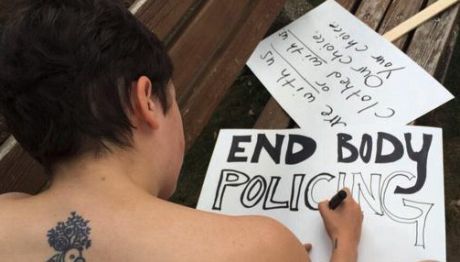Features
You are here
What we wear: it's a woman's right to choose

August 15, 2015
Despite several decades since the women's liberation movement first raised the notion that women should have control over our bodies and what we choose to wear on them, we live in a society just as obsessed with regulating what women wear.
Women are blamed for the sexualisation of their body if they choose to reveal too much. Or they are blamed for blindly accepting “barbaric” beliefs if they choose to wear the hijab or niqab. You’re either covering too much or not enough: either way, women are robbed of the fact that our bodies are our own.
In Waterloo on August 1, around 300 people rallied at a protest called “Bare With Us” with signs reading "Nudity isn't sexual" and "They’re boobs, not bombs” to support the Mohammed sisters—three young women who were stopped by Kitchener police for riding bikes home topless on a hot summer night. One of them is Juno-nominated Alysha Brilla (her stage name), and she appeared at the rally side by side with a topless Gwen Jacob.
Gwen Jacob
In 1991, Gwen Jacob—then a19-year-old female University of Guelph student—became an “accidental activist” by taking off her shirt on a hot day and walking bare-chested through Guelph. She was arrested, charged with indecency, convicted and fined $75. She fought it, and the case ignited a nationwide debate: the Ontario Court of Appeal quashed the conviction, making toplessness legal.
At the time, the debate was about “indecency,” and feminists, socialists and others on the left defended the right of women to challenge being held to a different standard of decency than men. At the same time, there was also a critique of the purely legal right, abstracted from the systemic sexualization of women’s breasts, that prevents most women from exercising it for fear of harassment—particularly women who are already most vulnerable to harassment and sexual violence, including racialized, queer and disabled women.
Rape culture
The timing of the recent topless protest in Kitchener-Waterloo raises two issues. The ongoing “war on terror,” and attack on cultures that sexualize the uncovering of hair like the uncovering of breasts, is one. But there is another: the Ghomeshi, Cosby, and Dalhousie Dentistry scandals, and the growing challenge to rape culture.
Some critical comments about the “Bare With Us” protest have suggested that both women and men should show more modesty in an effort to combat sexual violence. For example, Wendy Shalit, the US author of A Return to Modesty: Discovering the Lost Virtue, argues modesty helps fight misogyny: “Fighting over-sexualisation by giving strangers more access to women’s bodies? To me that doesn’t make much sense. It’s like protesting low wages by working for free. Instead I’d love to see a higher standard of decency, for both men and women.”
But such arguments harken back to the impetus for the “Slut Walk" movement, which began in 2011 after a Toronto Police officer suggested that "women should avoid dressing like sluts" as a precaution against sexual assault. It became an international movement against blaming victims of sexual assault for “asking for it.” It has predecessors in the “Take Back the Night” marches in parts of North America, which raised the chant: “However we dress, wherever we go, yes means yes and no means no.”
It’s not about decency
The issue is not “decency” but the systemic sexual oppression of women that relies on the role of women in the home and in procreation—no matter how much progress has been made to create a different social role for women.
Because the female body and its role in procreation and domestic care has not been fully liberated from being defined in that way, our capitalist society continues to assign it a fundamentally sexualized role. And because the market turns everything into a commodity, including sexuality, and because our relationship to sexuality is distorted by capitalist society—which alienates us from our most natural selves—the female body remains a battleground.
Last May, Guelph high school principal Scot Bishop made the news when he told students to keep it “scholarly, not skanky,” while speaking over Centennial Collegiate Vocational Institute’s P.A. system. His students rallied outside the school wearing signs and clothing reading “my education is more important than what I wear” and “my body, my choice!” A couple of weeks later, high school students of all genders at Etobicoke School for the Arts, bared their stomachs and shoulders in protest after school officials pulled 18-year-old Alexi Halket out of class for wearing a crop top in an action called #croptopday.
In the same week the Mohammed sisters were stopped in Kitchener, a woman going topless in BC was told by police to cover up, only to find out later that it has also been legal in BC since the 90s. Earlier this summer in Guelph a 6-year-old was told she had to cover up after she joined her brothers in taking off her shirt to get in a splashpad. There is no end to female bodyshaming.
Choice
The decision of what to cover and what not to cover can only be a truly free one when women are free of the much broader constraints over the role ascribed to gender in society.
In the meantime, the fight for the individual choice to go topless, even if we don’t all feel comfortable doing so, and the fight to wear the hijab or niqab, even if we don’t all feel comfortable doing so, must be respected.
Section:
Topics:










